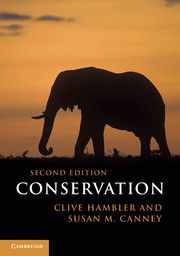Book contents
- Frontmatter
- Contents
- Preface to the Second Edition
- 1 Introduction to conservation
- 2 Threats to biodiversity
- 3 Evaluation of priorities for species and habitats
- 4 Monitoring and Environmental Impact Assessment
- 5 Management of natural and fragmented habitats
- 6 Management of species
- 7 Sustainable use, semi-natural cultural landscapes and the matrix
- 8 Restoration and offsetting
- 9 Environmental policy
- References
- Index to species names
- Index
- Plate section
2 - Threats to biodiversity
Published online by Cambridge University Press: 05 February 2013
- Frontmatter
- Contents
- Preface to the Second Edition
- 1 Introduction to conservation
- 2 Threats to biodiversity
- 3 Evaluation of priorities for species and habitats
- 4 Monitoring and Environmental Impact Assessment
- 5 Management of natural and fragmented habitats
- 6 Management of species
- 7 Sustainable use, semi-natural cultural landscapes and the matrix
- 8 Restoration and offsetting
- 9 Environmental policy
- References
- Index to species names
- Index
- Plate section
Summary
This chapter examines some of the main threats to biodiversity. Humans have caused extinctions and habitat alterations for over 45 000 years. We examine the importance of human population growth and of our consumption of resources such as energy, food, water and land. We also examine the problem of pollution, which occurs once the limited capacity of the environment to deal with waste is exceeded. We then turn to introduced species.
Most species are threatened by several factors, some of which are not known. Threats can cause extinctions directly or can cause ‘secondary extinctions’ through environmental changes. The amount of extinction and habitat change that humans have caused during the Holocene (the 11 500 years since the last ice age) is increasingly apparent, as are some of the causes (Williams, 2006; Turvey, 2009).
Identifying causes of recent extinctions
What has caused the rise in extinction rates? Very few extinctions have been observed, and it is often difficult to identify the cause of an extinction. It is hard to find and study the last individuals of a species, even if we know the species exists. The threats to individual species often have to be identified using detailed studies of their ecology (autecology), revealing their requirements and mortality from different causes at different ages and regions (Section 6.3). In order to identify important drivers of extinction, a standard terminology is being developed (Salafsky et al., 2008; Hayward, 2009). This will permit threats to species to be listed in a consistent way, with a global perspective. We also need to distinguish between the proximate causes of extinction, such as land conversion, overhunting and pollution, and the underlying drivers of extinction, which encompass societal and cultural forces of population, politics and economics; and science and technology (Chapter 9).
- Type
- Chapter
- Information
- Conservation , pp. 41 - 86Publisher: Cambridge University PressPrint publication year: 2013



